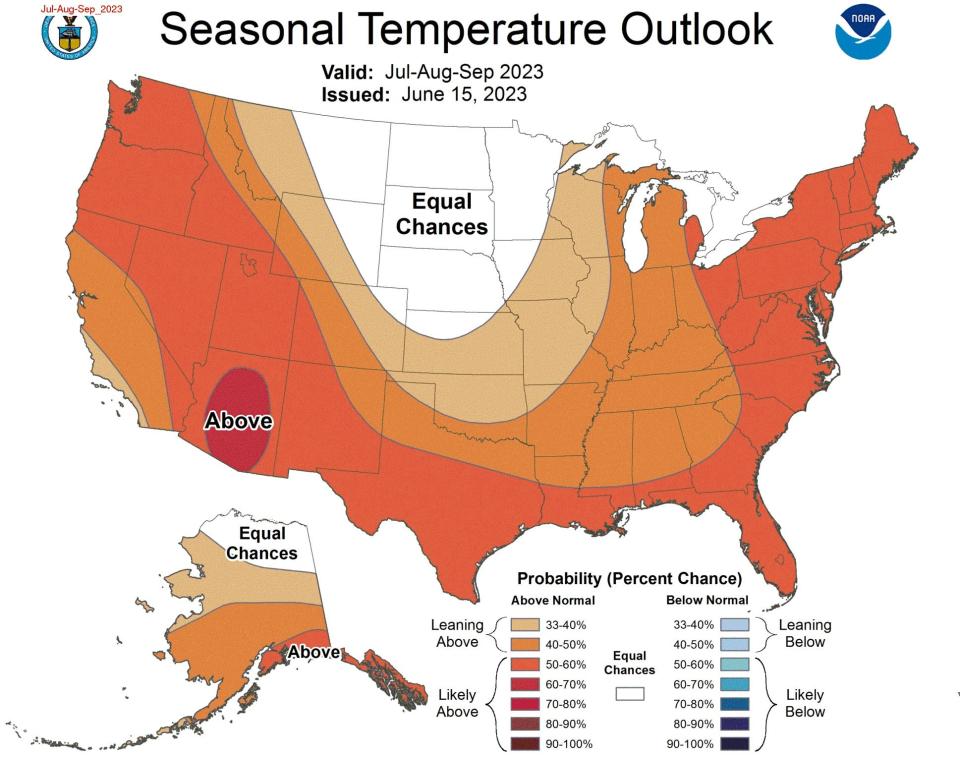'That’s going to be a problem': Summer 2023 is shaping up to be sweltering and smoky
Summer 2023 in the U.S. has started with deadly heat and dangerous air as heat domes and wildfire effects plague tens of millions of Americans.
Get used to it, experts say, as both the heat and the smoke are likely here to stay.
Thanks to the ongoing wildfires in Canada, which show no sign of ending, smoky air is set to be a regular, periodic occurrence down here in the U.S. throughout the rest of the summer, experts said.
"As long as those fires keep burning up there, that’s going to be a problem for us," said Weather Prediction Center forecast operations chief Greg Carbin. "As long as there’s something to burn, there will be smoke we have to deal with."
And as for the heat, if you're sick of it already, there's not much relief in sight: Federal forecasters are predicting a warmer-than-average summer for most of the country.
Smoke risk not likely to ease soon, thanks to stuck pattern
An unusually persistent, stuck weather pattern, which continues to periodically funnel foul, smoke-filled air over U.S. cities from Chicago to Washington, shows no sign of changing or letting up.
"While the fires are ongoing, you can expect to see these periodic bad air days," said University of Chicago atmospheric scientist Liz Moyer. "And the only relief is either when the fires go out or when the weather pattern dies."
In addition, the wildfire forecast from Canada remains grim: Current projections indicate the potential for continued "higher-than-normal fire activity across most of the country throughout the 2023 wildland fire season, due to ongoing drought and long-range forecasts for warm temperatures," according to Natural Resources Canada.

Hot forecast for the rest of summer 2023
A hot summer also seems likely, meteorologists say.
Specifically, above-normal temperatures are expected throughout a majority of the U.S. during July, August and September, according to Climate Prediction Center meteorologist Brad Pugh.
Pugh said the highest probabilities of above-normal temperatures are forecast across parts of California, the Pacific Northwest, the Great Basin, the Southwest, the Gulf Coast and the East. No parts of the country are expected to see cooler-than-average temperatures for the next three months, he said.
Heat wave easing in the South, for now
The deadly heat that has scorched Texas for weeks now has finally eased, forecasters said, but with the nation entering the hottest month of the year this weekend, the heat is far from over.
“It’s relief from the extreme heat,” National Weather Service meteorologist Bryan Jackson said. “It’s not really an end to a heat wave; it’s just an end to the extreme part of the heat wave.”
The sweltering temperatures – which have been responsible for at least 14 deaths – were brought on by a heat dome parked over Texas that taxed the power grid and brought record highs to parts of the state, according to meteorologists.
That heat dome has spread eastward, and by the weekend was expected to "gradually weaken" over the mid-South, the Weather Prediction Center said.
Still, the weather service on Saturday said sweltering temperatures are expected to continue in cities along the Gulf Coast, and Lower Mississippi Valley and Southeast regions are expected to break their daily warmest nighttime low records through the weekend. Heat-related danger remains elevated due to the longevity of this heat wave, the weather service said.

West will get in on the extreme heat
A separate dome of heat has developed on the West Coast, and an excessive heat warning was in place in a wide swath in the central part of California, Jackson said.
Much of the West will see hot, dry conditions forecast through the Fourth of July, raising concerns about the danger of fireworks shows and wildfires.
“By this weekend there is a risk for record high temperatures exceeding 100 degrees … close to 110 degrees in the Central Valley of California,” Jackson said. “Then some of the more typical midsummer heat of getting above 115 degrees in the hottest areas of the Desert Southwest.”
An excessive heat warning was in effect for much of the Desert Southwest for the weekend and temperatures are expected to climb well into the 110s, the weather service said. The risk of heat-related illnesses will be high through the weekend. That includes notorious hot spot Death Valley, California, which is forecast to see a high of 123 degrees by Sunday, the weather service said.
July typically the hottest month of the year in the US
It's not exactly news that it's hot in July: Climatologically speaking, July is the hottest month of the year for the contiguous United States, with an average temperature of 73.6 degrees, the National Centers for Environmental Information said. The average daytime high temperature is nearly 87 degrees, and the average nighttime low is about 60 degrees.
The hottest July – and the hottest month overall – on record for the contiguous U.S. came in 1936 during the Dust Bowl. The July 1936 average temperature was 76.8 degrees, which is 3.2 degrees above the 20th-century average.
The USA's hottest state, on average, in July is Texas.
The July temperature for the contiguous United States has warmed at an average rate of 1.2 degrees per century since 1895. Since 1950, the rate of change is double that at 2.4 degrees per century.
Contributing: The Associated Press
This article originally appeared on USA TODAY: Smoke, heat wave forecast for summer 2023 is looking bad, experts say

